#the light in the piazza 2019
Text
The Gilded Age's Broadway Divas: Aurora Fane (Kelli O'Hara)
Beloved by all, Aurora Fane enjoys a powerful position in Mrs. Astor's New York. Having suitably recovered from impending financial ruin last season, this season, Aurora has done some ill-fated matchmaking, worn some fantastic hats, and provided beautiful window dressing to scenes where she just sits there and looks pretty.
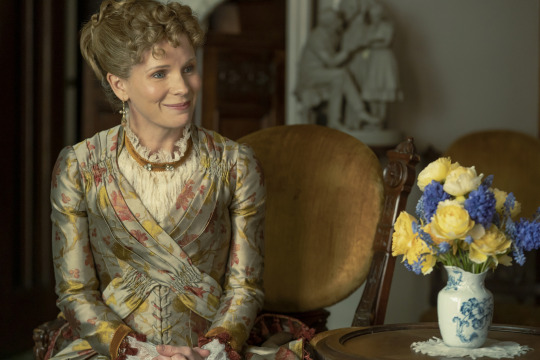
One of Broadway's (few) leading sopranos, Kelli O'Hara is a dying breed. As trends shift towards a more pop/rock sound, and classical musical theatre becomes a thing of the past, Kelli nevertheless finds her niche. A seven-time Tony nominee, Kelli has won Best Leading Actress in a Musical for the 2015 revival of The King and I. You'll recall another Gilded Age Diva who won for that same role some years prior. A proshot of the NT Live production can be found online. It is a gorgeous shoot, even if I take issue with that show as a whole.
She has also been nominated for Kiss Me, Kate (2019), The Bridges of Madison County (2014), and The Light in the Piazza (2005). Ironically, though Aurora Fane supports The Academy, Kelli is a classically trained opera singer who has appeared on the Met Opera stage three times, and will play Laura Brown in an encore run of The Hours this spring. (See my breakdown post over costumes here.)
However, prior to her opera appearance, Kelli will be starring in the new Broadway musical Days of Wine and Roses for a limited 16-week run, opening on January 28th. Kelli has been nominated for every role she has played since 2005, and this will almost certainly be no different. Booked and busy.
#1: "Shall We Dance?" The King and I (2015)
youtube
Kelli's voice is otherworldly angelic. That much we already know very well. The King and I opened in 2015 at the Vivian Beaumont Theatre at Lincoln Center, the third musical Kelli has starred in at that venue. The Beaumont is, of course, right next to The Met Opera, and the only Broadway theater outside the theatre district in Midtown.
As Anna Leonowens, Kelli travels to Siam to teach the children and wives of the king how to speak English. Orientalism aside, the show is a classic Rodgers and Hammerstein, and the score is divine in Kelli's mouth. Fun fact: Kelli's replacement was Marin Mazzie in one of her last onstage roles. Marin was the Passion co-star and dear friend to Donna Murphy, our Mrs. Astor.
This video is from the 2015 Tony performance and showcases the incredible quick change Kelli makes between singing "Getting to Know You" and "Shall We Dance?" aided by a team of unbelievable dressers. It is a marvel to witness. As is Ruthie Ann Miles, Kelli's co-star who recently performed in the Encores! production of Light in the Piazza.
#2: "What More Do I Need?" Take Me to the World: A Sondheim 90th Birthday Celebration (2020)
youtube
In 2020, despite a global pandemic, the theatre community still found a way to honor Stephen Sondheim's milestone 90th birthday with an online concert. Kelli performed a song from Saturday Night, Sondheim's first professional musical that was slated for Broadway in 1955, but was scrapped. It only got its New York premiere in 2000. This particular number is a cabaret favorite, and Kelli is an absolute delight with just a camera and digital accompaniment.
Fun fact: it wasn't until this particular performance that I truly started to appreciate the wonder that is Kelli O'Hara. I had previously seen her in concert just that March, and loved her, of course, but I have a complex relationships with sopranos. I now recognize that I love mature sopranos, but it's the ingenues I can't listen to without wincing.
#3: "They Don't Let You In the Opera" (2016)
youtube
Lest we think Kelli is limited in her range and style, this song was written especially for her to showcase her vast talent and comedic timing. Kelli, an Oklahoma farmgirl, isn't the sort of person you'd expect to be both classically trained and country literate.
Kelli, who has been typecast as refined and often repressed characters who go through harrowing emotional experiences, much like Aurora Fane, is more than capable of bringing a rollicking comedy to the mix.
This number is a favorite in Kelli's concert repertoire. There isn't much more to say, except that you need to witness its hilarity for yourself.
#4: “Heaven? Somebody else’s heaven?” The Hours (2023)
youtube
Speaking of opera, here is an excerpt from a scene in Act II where Laura Brown has fled to a hotel room to contemplate some very serious courses of action. Kelli, alongside soprano Renee Fleming and mezzo-soprano Joyce DiDonato, makes up a trio of phenomenal women in Kevin Putts' adaptation of the book and movie.
The Met Opera theatre seats nearly 4,000 people across six levels. The performers do not use body mics or amplification of any kind, but rather rely on intense vocal training to be heard across the theater. For this reason, alongside the vastly different vocal techniques and styles, musical theatre actors rarely cross over into opera, and vice versa. Notable exceptions include Renee Fleming, Kelli's Light in the Piazza co-star Victoria Clark, and Mary Beth Peil, who made her musical theatre debut in The King and I as yet another Miss Anna, hers in 1985.
#5: "So in Love," Kiss Me, Kate (2019)
youtube
Starring in yet another Golden Age musical revival, Kelli brings a different take on Lilli Vanessi, a glamorous movie star in a turbulent relationship. Kelli's vocal talent, of course, speaks for itself. For Kelli, this role was a tribute to her dear friend, the late Marin Mazzie, who had passed away some months before the show opened. Marin, who replaced Kelli in The King and I, had played this same role in the 1999 Broadway revival to great acclaim. In her first entrance of the show, Kelli wore a costume that featured the very same hat Marin wore in her show.
Though this video is beloved, my personal favorite rendition can be heard below. It was taken at a concert Kelli put on at the 92Y in New York last February. In it, Kelli sings for and to Marin, and the entire theatre wept.
Bonus: "Back to Before," Ragtime Reunion Concert (2023)
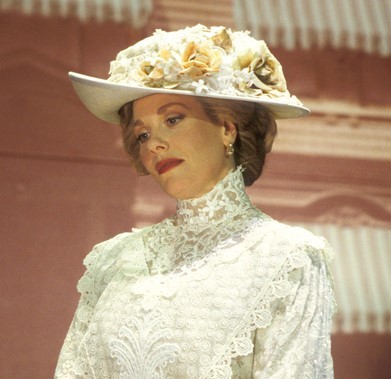
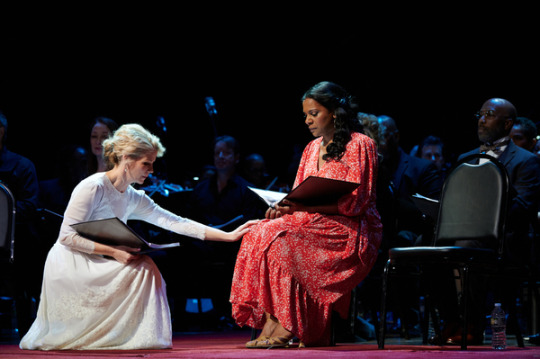
The role of Mother was originally workshopped by Donna Murphy in Toronto in the early 90s, but she left to do King and I, which worked out well for her. In came dear friend Marin Mazzie, who originated the role on Broadway, and established a precedent no other has been able to top. Also in that cast? Audra McDonald as Sarah, for which she won a Tony, of course.
In 2023, after years of pandemic-related delays, they staged a one-night reunion concert of this special show. And who better to take on Marin's iconic role than Kelli O'Hara? Listen to her "Back to Before" here, and then do yourself a favor and run, don't walk, to listen to Marin's.
#the gilded age#aurora fane#kelli o'hara#met opera#sondheim#ragtime#marin mazzie#kiss me kate#the hours#the king and i
19 notes
·
View notes
Photo



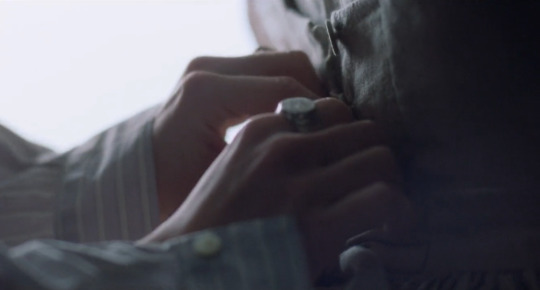
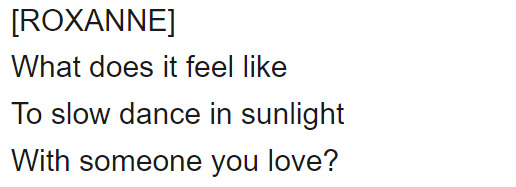
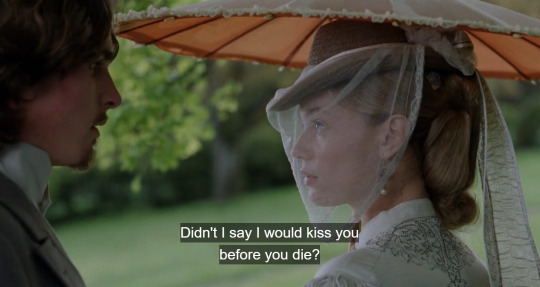
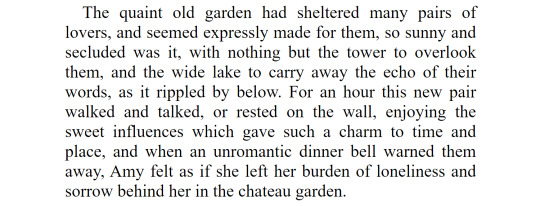
octet - the light in the piazza / little women (2017) / pierre & natasha - natasha, pierre & the great comet of 1812 / little women (2019) / someone to say - cyrano (2022) / little women (1994) / little women - louisa may alcott
#this post is about amy and laurie could you tell#little women#amy x laurie#web weaving#sorry i love these white people so much. my favorite white pairing
94 notes
·
View notes
Text
Alonso also has 40 home runs alongside HOF legend
Alonso also has 40 home runs alongside HOF legend
Pete Alonso (29, New York Mets) has conquered the 40-homer mark of the season.
Alonso started as the fourth batter and first baseman in the home game against the Seattle Mariners in City Field, New York, on the 4th (Korea Standard Time), leading his team to a 6-3 victory with three hits (two home runs) and four RBIs in four at-bats.
It was more like a one-man show. Alonso hit a timely RBI with two outs and a runner on first base in the bottom of the first inning when he faced 0-0. He then hit his 40th home run of the season in the bottom of the third inning with a 2-0 lead over the left fence to a line drive. Seattle right-hander George Kirby's fourth curve was pulled to lead to a 385-foot (117.3m) long drive. Alonso is the third player to surpass 40 home runs this season after Shohei Otani (LA Angels) and Matt Olson (Atlanta Braves, 44 home runs). Kyle Schwaber (Philadelphia Phillies, 39) and Mookie Betts (LA Dodgers, 38) also approached 40 home runs, but Alonso's bat turned fiercely first.
Alonso, who made his big league debut in 2019, hit 40 home runs in his third season following 2019 (53 home runs) and 2022 (40 home runs). MLB Dotcom, the official website of Major League Baseball, said, "The only big leaguers who recorded 40 home runs three times in the first five seasons were Ralph Keiner, Eddie Matthews, Albert Pujols, and Ryan Howard. Two of them (Kainer, Matthews) entered the Hall of Fame (HOF) and the third player (Puhols) will soon enter, he said, shedding light on Alonso's record.
Alonso's bet didn't stop in the seventh inning. Seattle right-hander Trent Thornton hit his third four-seam fastball in the seventh inning with one out and no runner in the seventh inning, which was chased 5-3, and crossed the left-center fence. The distance was measured at 397 feet (121 meters). The 187th home run of his career. MLB.Com ranks Alonso fifth in the Mets' history home run after Darryl Strawberry (252), David Wright, Mike Piazza, and Howard Johnson. If Alonso stays in Flushing (Mets) for a long time, it is almost certain that he will become the Mets' all-time home run king in early 2025.
Alonso joined the Mets in the second round of the 2016 rookie draft, 64th overall. He exploded 53 home runs (120 RBIs) in 2019, breaking the record for the most home runs (52) in a season of MLB rookies achieved by Aaron Judge (New York Yankees) in 2017, becoming the NL Rookie of the Year. That year, Cody Bellinger (then LA Dodgers) set a new record of 39 home runs for NL rookies in 2017, and surpassed the single-season Mets record of 41 held by Todd Hundley in 1996 and Carlos Beltran in 2006. His career record is .254 with 187 home runs and 480 RBIs.
0 notes
Video
vimeo
STEFANO FAKE & THE FAKE FACTORY - GUSTAV KLIMT - IMMERSIVE ART EXPERIENCE from the fake factory on Vimeo.
Stefano Fake is an Italian artist and video designer who creates installations using video projections, films, photographs, sculptures, computer graphics and interactive technologies. He is a pioneer and one of the main contemporary exponents of Immersive Art, which aims to sensorially immerse the viewer within the work of art itself. Graduated in Political Science in Milan, followed Masters in directing in Madrid, Los Angeles and New York. From 1997 to 2007 he moved to Florence and created the virtual sets for the Krypton Theater Company. In 2001 he founded The Fake Factory, a studio specialized in Immersive Art, Projection Art and Videomapping. In just a few years, this laboratory becomes a point of reference in the context of digital and immersive art at a national and international level, participating in the creation of numerous projects: immersive exhibitions, video mapping, architectural light installations, video production, video scenography for theatres, fashion, visual environments for museums, galleries and cultural events, production of multi-sensory works, video installations, video art works. In 2005 he made one of his first 3D videomappings (architectural video projections that redesign the facades of buildings with optical illusions), this technique will be reused several times by The Fake Factory: Bastioni di Porta Venezia, Piazza Campidoglio Rome, Castello Sforzesco Milan, Ponte Vecchio, Carrara marble quarries, Palazzo del Senato Milan, Basilica of Santo Spirito Florence, Villa Ephrussi de Rothschild, Teatro della Pegola Florence, Stazione Leopolda, Palazzo Marino, Palazzo Corsini, Opera di Firenze, Palazzo della Farnesina, Condeduque Madrid. In 2006 he began exhibiting the Immersive Mirror Rooms, immersive environments created with video projections and reflective surfaces.
Since 2010 he has been collaborating with the Italian Cinema Orchestra to bring film soundtracks to the world through multimedia concerts. Since 2015 he has been creating Immersive Exhibitions in Italy and in the world, reinterpreting the works of artists of the past with digital languages and technologies. His works (The Italian Beauty, Caravaggio Experience, Klimt Experience, Colors Art Experience, Monet Experience and the French Impressionists, Modigliani Art Experience, Leonardo da Vinci Body Immersion, Leonardo & Warhol The Genius Experience, Inside Magritte, Bach Experience) define the format internationally, thanks to an unprecedented success with audiences and critics (+ 5 million visitors overall in the period 2015-2022). Since 2019 he has been the creator and artistic director of the FARNESINA DIGITAL ART EXPERIENCE project, in collaboration with the Italian Ministry of Foreign Affairs, with the aim of producing, exhibiting and communicating Italian digital art in the world. Websites: stefanofake.art / thefakefactory.art / immersiveexperience.art / immersivemirrorroom.art / fakeartist.art
#ImmersiveArt
#ArteImmersiva
#ImmersiveArtExperience
#ImmersiveExperience
#stefanofake
#thefakefactory
#ImmersiveMuseum
#esperienzaimmersiva
#immersiveinstallation
#immersiveexhibition
#ArtImmersion
#videomapping
#FakeMirror
#MirrorRoom
#ImmersiveMirrorRoom
#mostraimmersiva
#ProjectionArt
#ProjectionMapping
#Videomapping
#DigitalArt
#DigitalArtExhibition
#ImmerseYourselfInArt
#InsideArt
#ImmersionRoom
#experienciainmersiva
#experienciamultisensorial
#newmedia
#newmediaart
#contemporaryart
#instalacióninmersiva
#videoart
#visualart
0 notes
Text
Ettore Spalletti
‘I like to think of myself as a figurative painter like Turner rather than an artist. I love Turner a lot. When I use pink, I think of the complexion of human skin that changes along with our mood, while blue is atmospheric, it’s a colour in which we are constantly immersed, it’s the colour of the sky. White is the colour of the light, and grey is the colour of reception because it’s able to unite all the other colours. A grey, for example, can lead you to blue, cobalt and ultramarine, but also to purple.’ - Ettore Spalletti, 2016
Ettore Spalletti (1940-2019) was born in Cappelle sul Tavo (Pescara). He began his career when Arte Povera was revolutionizing visual culture in Italy and beyond. Spalletti developed a singular, solitary voice and a resultant body of work that exceeds any movement that circumscribes an artist to regional or ideological boundaries. Spalletti’s formal vocabulary has always melded and balanced painting and sculpture, form and colour, interior and exterior space. Each work is the result of a meditative but rigorous process of applying a layer of colour at the same time of each day, to capture a specific tone that recalls an hour, a season, and the weather.
Spalletti would first create a paste, to which he would add colour and, once dry, work the surface with sandpaper, resulting in an inviting powder quality. These lustrous hues covered not only traditional rectangular surfaces but also columns, floors, walls, and shaped supports. Inspired by painters like Masaccio and Piero della Francesca, as well as by the tones of the Abruzzo region in which he lived, Spalletti’s works have been variously compared to the work of Anne Truitt, Mark Rothko, and Ellsworth Kelly.
📷 1. Ettore Spalletti, Azzurro della sera, 2016, Marian Goodman Gallery
2. Ettore Spalletti, Carta, 2013, Marian Goodman Gallery
3. Ettore Spalletti, Parole di colore, rossoazzurro, 2011, Marian Goodman Gallery
4. Ettore Spalletti in his Moscufo studio with Stanza Azzurra, Dedicata a Mio Fratello che Amava Gli Azzurri, 2006. Photography by Matteo Piazza


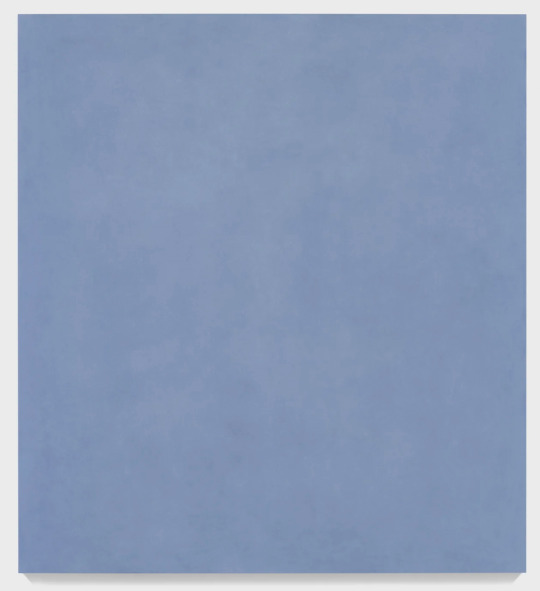
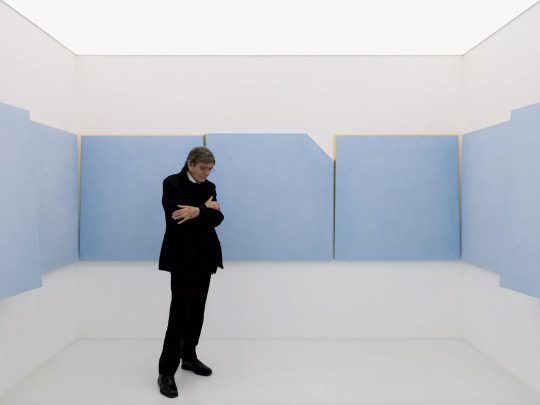
1 note
·
View note
Text
Lecce, la Festa dei Santi Patroni Oronzo, Giusto e Fortunato
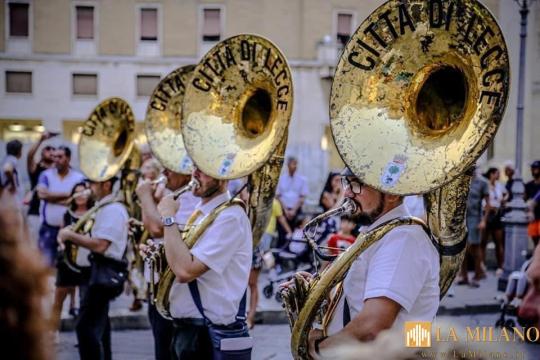
Lecce, la Festa dei Santi Patroni Oronzo, Giusto e Fortunato.
L'attesa è finita: ritorna, dopo due anni di pandemia, la Festa dei Santi Patroni Oronzo, Giusto e Fortunato. Nelle vie del centro si potrà passeggiare fra stand e bancarelle della tradizionale fiera, allestita lungo il percorso abituale (via Cavallotti, viale Marconi, viale Lo Re, via XXV Luglio, via Costa), che coinvolgerà 210 operatori, per la quale è stata confermata la scelta ecosostenibile fatta nel 2018 e nel 2019 di bandire i gruppi elettrogeni e approvvigionare di energia i commercianti con un’apposita infrastruttura elettrica messa a punto dai tecnici del Comune. Meno inquinamento acustico e ambientale, più decoro e vivibilità.
Su via Trinchese, nel tratto che costeggia il Teatro Apollo, torna anche l'anteprima della Fiera di Santa Lucia, dei Presepi e dei pastori, un'esposizione dei lavori artigianali della storica fiera, protagonista del Natale in città, a beneficio dei turisti. Il Luna Park in piazzale Rozzi è già attivo e lo resterà fino a venerdì.
In Piazza Sant'Oronzo, si accenderà la cassa armonica e le luminarie di Mariano Light che abbelliscono il percorso....
Read the full article
0 notes
Text
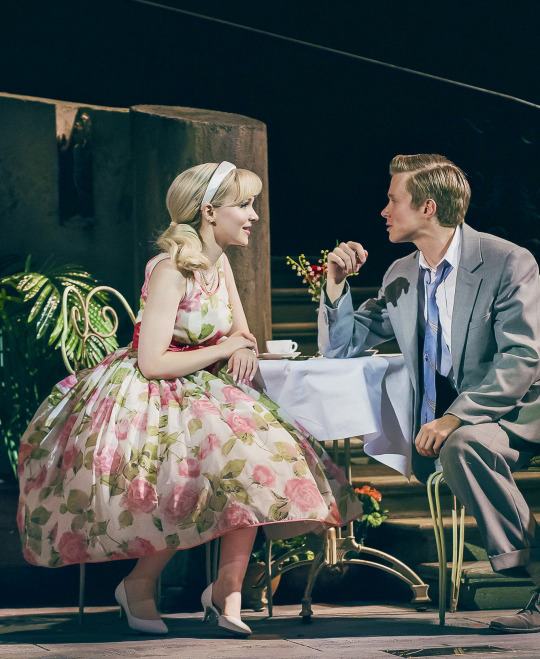
The Light in the Piazza (2019) in London, Los Angeles and Chicago
#the light in the piazza#the light in the piazza 2019#stage costumes#theatreedit#theatre costumes#dove cameron#musicaledit#musicals#rob houchen#1950's clothing#1950s style#1950s#1950s aesthetic#1950s fashion#20th century#flower pattern#blonde#half up hair#romantic aesthetic#romantic#couple#clara johnson#fabrizio naccarelli#pink roses#white shoes#white dress#source: historical beauty lily#pink lips#pearl necklace
142 notes
·
View notes
Photo



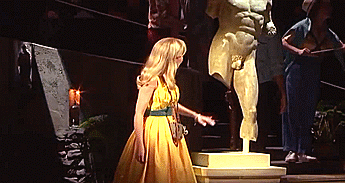






The Light in the Piazza (Southbank Centre)
#the light in the piazza#my gifs: the light in the piazza#the light in the piazza 2019#my gifs: the light in the piazza 2019#musical#musicals#musical theatre#mine#dove cameron#clara johnson#renée fleming#margaret johnson#alex jennings#signor naccarelli#rob houchen#fabrizio naccarelli#musicalgifs
74 notes
·
View notes
Text
Musical Movie Adaptations
I feel like there are roughly three categories of musicals when talking about possible film adaptations. There are the ones like In The Heights or Into The Woods that have the potential to be great movies because there’s nothing in them that 100% ties them to the stage and they already have cinematic qualities. There are the ones like Hadestown and Spring Awakening that rely so much on the atmosphere and the energy of the audience that turning them into films could ruin that spark of something that makes them good in the first place, but would also be gorgeous on film if done correctly. And then you’ve got. Y’know. Cats and shows like it that are fundamentally dubious adaptation material because their theatricality is part of what makes them work.
Anyway.
Category One: “Would Make Beautiful Movies”
Dear Evan Hansen
Wicked
The Light in the Piazza
Tuck Everlasting
Category Two: “Could be Gorgeous, but Easily Ruined”
Hadestown
Hamilton
Spring Awakening
Next To Normal
Come From Away
Bandstand
Category Three: “Adapt at Your Own Risk”
Fun Home
Merrily We Roll Along
25th Annual Putnam County Spelling Bee
The Book of Mormon
Falsettos
#movie musicals#cats#cats the musical#cats 2019#dear evan hansen#the light in the piazza#tuck everlasting#hamilton#hadestown#musical theatre#film adaptation#spelling bee#25th Annual Putnam Country Spelling Bee#merrily we roll along#wicked#wicked movie#spring awakening#dwsa
332 notes
·
View notes
Text
wow i can't believe kelli ohara invented italy
#i am well aware i already put this on twitter#kelli ohara#july 3 2019#light in the piazza#litp#bridges of madison county#francesca johnson#clara johnson
11 notes
·
View notes
Text


light in the piazza press (2019)
67 notes
·
View notes
Note
What musicals do you recommend for people like me who really enjoy musicals like A Tale of Two Cities? (The full thing is amazing, omg.)
Here are some musicals I recommend if you like A Tale of Two Cities. (some of these you might already know.) This is gonna be long-winded. I hope it's helpful :-)
-les miserables*
-the phantom of the opera
-the secret garden
-jane eyre
-hadestown (I HIGHLY recommend the nytw version)
these musicals contain things like grief, lost love, found family, redemption and the like. The music in Les Mis is probably the least like Two Cities. It has some beautiful pieces, but it also has a lot of "Spoken' singing which is more metronomic and staccato.
Hadestown doesn't have much in common with a Two Cities, but I put it on here because it is one of my favorite musicals ever and I think if you like Two Cites you'll like Hadestown. It's very folksy with a new orleans undertone. It's all about trust, loyalty and hope, and what happens when those things are challenged or betrayed. It's hecka sad but it is so beautiful.
The Phantom of the Opera is much more of a classic piece. It has a lot in common music-wise with a Tale of Two cities, but the plot is very different. I wouldn't be surprised if you already know a lot about Phantom. It's very popular.
other musicals I'd recommend that are totally unrelated:
-Bright Star**
-Bandstand
-Before/After
-The Light in the Piazza
-The Scarlet Pimpernel (I'm not a huge fan of Pimpernel but it does have some good music which sounds very similar to Two Cities.)
Musicals that are more pop/rock
-next to normal
-ghost
-finding neverland
-a bronx tale
*the link provided is my personal favorite. I have some hardcore nostalgia because it is the first Les Mis I listened to and most of the cast is amazing. Enjorlas is a young Anthony Warlow, Marius is a young Michael Ball, and Javert is Phililp Quast. The Eponine is great too, Kaho Shimada. She's my favorite Eponine <3 But the Valjean is weaker than most, so I understand the people who don't like it as much. There are dozens of recordings on youtube, including the original broadway cast, the original london cast, the 10th anniversary, the 25th anniversary, the 2019 staged concert ( Michael Ball plays Javert with Alfie Boe as Valjean!! It has flaws but it's fun to watch and I think it's pretty good) basically search Les Mis and find the cast YOU like!
**This musical is a bluegrass country musical. It's way out of my comfort zone but holy cow is it good! There is a boot on youtube that is definitely worth the watch.
#asks#musical recs#musical theatre recs#rose recommends#musical theatre#musical list#musical theatre list
9 notes
·
View notes
Text

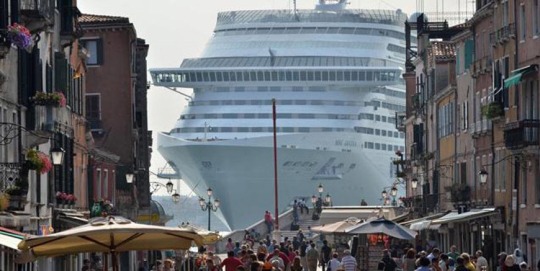
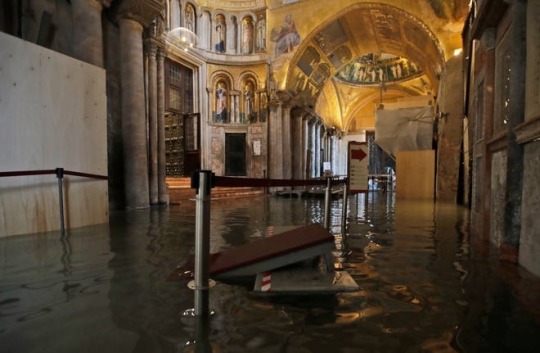
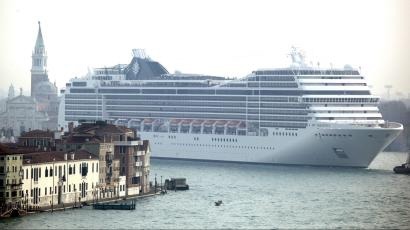
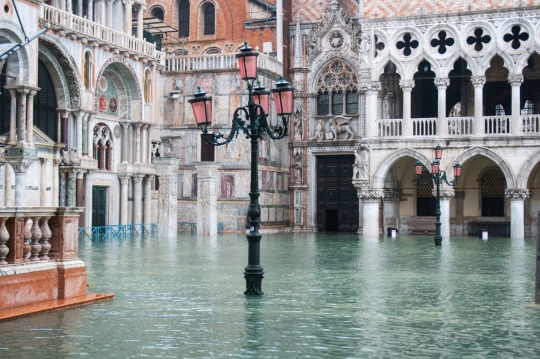

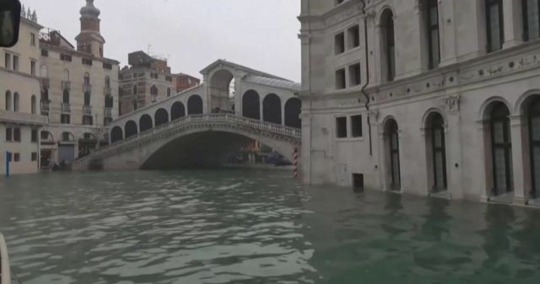


DEATH IN VENICE
THE MALIGN EFFECTS of mass tourism, a narrowly-based economy, and climactic change on the fragile city of Venice have been foreseen—and repeatedly experienced—for at least the past 30 years, but little of consequence has been done to mitigate them.
Venice grows more crowded and congested every year, but its population has been declining since the 1950s. Today, a scant 50,000 people reside permanently in the centro storico, down from 120,000 in 1950. Italians in general are fiercely loyal their birthplaces, but Venetians are reluctantly fleeing their native city, citing the degraded quality of life caused by the intolerable numbers of tourists and the rising cost of living in a city where basic types of businesses and residential housing are being replaced by souvenir shops and hotels.
The scourge of the city are the day-trippers who, 20 years ago, arrived by tourbus in lots of 100, but now come in 350m cruise ships carrying 2,000 passengers. The invading herds generate no income for hotels or restaurants, or the municipality which taxes both. The expense to the state and commune, however, is high. The heavy wear and tear on the unusual urban fabric of Venice requires costly maintenance and even more costly conservation work for the historical monuments.
With few Venetians in sight, tourists increasingly view the place as a theme park and selfie backdrop. This attitude was vividly illustrated by recent images of tourists making light of the record flooding in November 2019 by “swimming” in the Piazza San Marco as the monuments around them suffer catastrophic damage. This was an affront, but not a surprise, to the locals toiling with buckets and sandbags in the background.
These are the same residents, of course, who readily cashed in on the city’s glorious past and embraced tourism, making it a central component of the local economy. In 2019, tourism is the economy and Venetians are dependent on the very hoards of foreign sightseers destroying their way of life. The natives bemoan the gargantuan cruise ships towering over the city but, at the same time, they have built up a lucrative industry charging the large ships € 30,000 each for provisioning and servicing them. With the heavy industry on the terra firma in steep decline, the Venetians cannot afford to ban cruise ships or restrict the number of daily entries. As a result of these conflicting needs, anti-tourism measures are regularly proposed, only to be watered down or defeated. A recent decision to restrict large ship access to the Grande Canal will not be fully implemented until 2023. The Italian government has declared its opposition to Venetians’ proposed ban on cruise ships, many of which are built, owned and operated by Italian companies, and other plans to reduce tourism.
THE IMPROBABLE NOTION of city built in the middle sea with canals for streets and boats for taxis has been the key to Venice’s mystique for over a millennium. Aware of precarious nature of such a city, residents have sought to protect it from the sea and the elements by building barrier islands, dredging the lagoon and other major undertakings. In the past decade, however, those measures have proven inadequate to fend off the increased incidence of high tides caused by storms in the Adriatic. In the past, aque alte were annoyances confined to winter and major events like the flood of 1966 were highly unusual. Due to the rising sea levels and increasingly extreme weather caused by global warming, severe, even disastrous, aque alte are now regular occurrences year round. June 2018 saw aque alte. Tides exceeded 4.5 feet above sea level four times in November 2019. On 12 November 2019, flood waters reached 6 feet above sea level and flood waters inundated 85% of the cities streets. Damage to the 11th-century church of San Marco caused by flooding is expected to exceed € 27 million.

Defending the city against rising waters is clearly a much larger problem than tourism. The long-discussed plan, called Project MOSE (MOdulo Sperimentale Elettromeccanico), to build movable sea walls at the three inlets of the lagoon, meant to repel tidal surges, was finally begun in 2003. Quickly mired in kickback scandals, the completion date of 2018 has been changed to 2022. The entire project, however, reminds one of the Maginot line--a supposedly stalwart bastion that proved to be useless the first and only time it was deployed, and indeed, several of the gates installed in 2003 have already failed. Project MOSE also includes the reinforcement of coastlines, the rising of existing quays and the paving of the lagoon.
During the November flooding , the regional council of Venice held an emergency meeting to discuss measures to deal with the issues caused by climate change. So. severe were the high tides that the chamber in which they worked began to flood. Despite this vivid illustration of the magnitude of the problem, the council voted down every proposal for short-sighted reasons.
More bad news.
If you love Venice, stay home.
399 notes
·
View notes
Photo

The Italian publisher, editor and collector Franco Maria Ricci has died at the age of 82.
In sumptuously produced art books, and as editor of the bi-monthly art magazine FMR, Ricci published writing by Jorge Luis Borges, Italo Calvino, Umberto Eco, Roland Barthes and many others over the course of his long and distinguished career. In 2019, Susan Moore visited his estate at Fontanellato, near Parma, where in recent years Ricci had constructed the largest labyrinth in the world out of bamboo; they discussed Ricci’s notable collection of largely 18th- and 19th-century sculpture and paintings, as well as his library of books published by the great typographer Giambattista Bodoni, whose works Ricci had reprinted in his first foray into publishing. The interview is published in full below.
Collecting may be read as a form of autobiography written with works of art rather than words. In the case of Franco Maria Ricci, his is a life composed of both words and pictures. He has not only published the most lavishly produced art magazine – FMR – and art books in the world, but also spent the last 50 years amassing a peerless collection of volumes produced by the great Italian typographer, compositor and publisher Giambattista Bodoni (1740–1813) and a rich, eclectic collection of some 500 largely neoclassical and baroque paintings and sculptures. Both collections are at the heart of his most recent and extraordinary venture, the creation of the immense, star-shaped Labirinto della Masone, near Parma, the largest labyrinth in the world – and surely one of the few planted with bamboo.
There is something surreal, and slightly disturbing, about turning off the autostrada and suddenly encountering this majestic bamboo structure rising 10m or more above the plains of the Po valley. For all its elegant calligraphic stems and angular leaves, this is not the sparse specimen bamboo of Chinese ink-painting, but a forest. Here, more than 200,000 of these fast-growing bamboos arch upward in their quest for light. Once I turn into the drive of what was originally Ricci’s grandfather’s estate at Fontanellato, the brilliant azure June sky all but disappears. By the end of my two-day visit, it seems that the contrasts of light and dark are an apt metaphor for the book and art collections – and for the entire complex of maze, museum, archive and chapel, the latter built in the form of a pyramid. Ricci has always been part rationalist, part visionary.
Ricci’s story begins with the book. ‘I grew up surrounded by my father’s books. Reading Shakespeare, Homer, Joyce and Dante saved me from bad taste,’ he once said. ‘It made beauty simple, familiar and immediate in my eyes.’ It was a book, too, that transformed his life and launched a long and successful career: Bodoni’s Manuale tipografico, first published in 1818. Before his discovery of Bodoni’s works in the Biblioteca Palatina in Parma in the 1960s, a career in publishing seemed unlikely. The stylish Ricci, a racing driver and a dandy with dark cherubic curls, was best known for patterning the snow in the piazza around Parma Cathedral with the wheels of his E-type Jaguar. Even Bernardo Bertolucci remembered that car.
As a young man, Ricci had wanted to study archaeology, but an uncle in the oil world persuaded him to sign up for geology instead. After three months in Turkey spent looking for oil that was not there, he realised the oil business was not for him. Yet his education proved critical in unlikely ways. He spent weekends exploring the mysterious, labyrinthine underground tunnels and caves that are a feature of the Romagna region of Italy. He also designed posters for Parma University’s theatre festival that caught the attention of an American curator preparing a show of Italian design in New York. He became, inadvertently, a graphic artist, and went on to create striking graphics for everything from Poste Italiane to Alitalia.
Ricci has long insisted that ‘Bodoni was not only a typographer. He achieved modernity and elegance through graphic art. He was, like Canova, a champion of neoclassicism but in two dimensions. I immediately fell in love with the proportions, the concept of beauty.’ Bodoni’s genius was not simply the freshness, rigour and precision of the typefaces, with their dramatic contrasts between thick and thin line, but also his sense of how to lay out a page. Texts are set with extravagantly wide margins and with little or no decoration.
Ricci decided to reproduce the master’s Manuale tipografico, although everyone told him he was mad to do it. He bought two early offset typography machines which, he noted, were ‘as expensive as a Ferrari, which I wanted to buy but never did’, and had the highest-quality paper made exclusively for the project by Fabriano. It took a year to publish the three volumes in 900 numbered copies (1964–65). ‘So I became a publisher. It became a bestseller.’
Much to his mother’s horror, Ricci decided to continue to publish very expensive books – art books printed in Bodonian style – and later, literary editions, several series of which were edited by Jorge Luis Borges, whose presence looms large in library and labyrinth. At a time when Arte Povera dominated the Italian avant-garde, Ricci chose opulent black silk covers embossed with gold, and printed on costly pale blue Fabriano paper with handmade plates. He wanted his books to be rare – printing small editions – but also surprising. He gave Roland Barthes, Umberto Eco, Italo Calvino and Borges free rein to write accompanying texts.
His wife Laura Casalis remembers having been struck by the originality of Ricci’s 1970 book on the then little-appreciated Erté – text by Barthes – before she met the publisher himself in 1975, and soon found herself working on a book on red paper-cut portraits of Mao, accompanied by 39 of the Chairman’s own poems printed in Chinese characters. ‘Little by little I slipped into publishing with him – Franco was a workaholic and I realised that was the only way I would see him. Those Mao paper-cuts were typical of the practically unknown subjects that he would seek out all his life, and we sometimes show them between loan exhibitions in the museum. Franco has l’occhio lungo – he can see beauty in something which may take others a long time to recognise.’
It is in the library I find Ricci and, indeed, where he is to be found most mornings and afternoons. It is part of a cluster of picturesque 19th-century stone buildings surrounded by lush and increasingly exotic gardens. He had begun renovating the dilapidated stables behind his grandfather’s long-abandoned villa as a summerhouse and library in the 1970s, and its enormous hayloft still serves as an idyllic open-air dining room and entertaining space, even though the couple have now moved into the main house. Inside this romantic half-ruined folly, Ricci created the unexpected: two neoclassical library rooms lined with bookshelves and marble busts, their domed and coffered ceilings reminiscent of those in the Biblioteca Palatina.
As soon as we arrive in the inner sanctum, the Bodoni library with its more than 1,200 volumes – missing a tantalising three or four tomes but otherwise complete – Ricci is immediately up on his feet and pulling down and opening cherished volumes, eyes blazing. Despite the heat, he wears an elegant embroidered linen waistcoat but not its jacket, which hangs nearby, bearing the synthetic red flower that became in effect his iconographical device. (Tai Missoni gave him a cardigan as a present: Ricci declined the gift – he does not wear cardigans – but declared that he would always wear the red flower from its packaging thereafter, which he did. Once, when he had forgotten the flower, an officer at the Alitalia desk at Milan airport said: ‘I see you are travelling incognito today Mr Ricci.’)
Now Ricci deftly presents Bodoni’s Essai de caractères russes… of 1782, and his 1789 edition of Torquato Tasso’s pastoral play Aminta, exquisitely illuminated for the Prince of Essling. These are dear friends and the joy as he handles these pages is self-evident. This is the only significant part of the collection not to have been moved down to the museum and archive complex, a short bamboo-lined drive away. It is clear that he could never bear to live apart from these books.
The impetus to create the long-imagined labyrinth, and a museum and library to house his collections and publishing archive, was a diagnosis of Parkinson’s disease. The couple sold the publishing house in 1982, and their house in Milan, and moved to Fontanellato. There is a fierce pride in Laura Casalis’s voice as she explains: ‘Franco wanted to do it, he imagined it, and he found the right team of people to help him realise it.’ We are sitting over coffee in the Labirinto courtyard surveying the sharp-edged geometries of its rose-pink brick buildings, a place that already has the air of a lost ancient city discovered in a jungle. Laura describes the evolution of the museum collections within, and recalls the words of the late Italian publisher Valentino Bompiani, who described Ricci as a man of courage and fantasy.
‘Whenever he fell for some subject or artist, Franco would try to buy.’ Laura continues. ‘He was never concerned with what was or was not fashionable, and never bought to decorate a house. He collected pieces that he liked that were strange or unconventional.’ He began with Art Deco, first buying inexpensive little bronze and chryselephantine dancers by the likes of Demétre Chiparus (1886–1947), as well as Guiraud-Rivière’s dramatic figure of Isadora Duncan with two bears, which dominates the central space of the 20th-century gallery in the museum.
Here, too, are three paintings by the outsider artist Antonio Ligabue (1899–1965), a tormented soul who had led a tragic life, painting and wandering around the Po valley when he was not confined to a psychiatric hospital. Ricci published the first monograph on the artist in 1967, two years after his death, a work that helped catapult the artist from provincial to national and then international fame. Two years later, he bought two of the artist’s bold, visceral close-up heads of roaring tigers, painted in the 1950s, including the key work that had been selected for the book cover. A no less bright and richly impasted self-portrait in the guise of Vincent Van Gogh followed a year later.
Ricci also championed – and collected – the work of the third dominant presence in this space, Adolfo Wildt (1868–1931), often described as the last Symbolist but one whose reputation was, as Laura puts it, ‘tarnished by Fascist association’. Ricci published a monograph in 1988, the same year that he acquired the strange masterpiece that is Vir temporis acti of 1913, a virtuoso marble bust of a Greek or Roman soldier reimagined through the combined lenses of Michelangelo and the Secessionists. The expressive anguish of this head may be seen as a symbol of the nobility and redemption of sacrifice, but it is the refined and gleaming silken surface that led to Brancusi.
Ricci has a penchant not only for sculpture but also portraits, and portrait busts in particular. ‘I have hunted portraits all my life. I never get tired of looking at them,’ he confesses, ‘and in turn, I feel observed by them.’ In the 1990s, he began following the art market and collecting in earnest. Ricci had an office, bookshop and apartment in Paris and there and in Monaco he was to acquire many of his largely French 18th-century terracottas, some of the most compelling by less familiar names. A superb example is the bust of an intense, low-browed individual, signed by one A. Riffard and given the Revolutionary date of ‘9. Fructidor an 3e’, from 1794–95.
Another naturalistic tour de force is one of very few known terracottas by Francesco Orso, also known as François Orsy, a Piedmontese sculptor also active in Paris. Orso is responsible for the rarest sculptures here: the disconcerting life-size polychrome wax portrait busts of Vittorio Amadeo III of Savoy and his wife Maria Antonia Ferdinanda di Borbone, complete with painted papier-mâché clothes. The revolution destroyed the sculptor’s courtly patronage in Paris, and he diversified into the more overtly commercial world of the waxwork with a show featuring an effigy of the aristocratic revolutionary leader the Comte de Mirabeau and popular tableaux on themes such as Marat’s assassination by Charlotte Corday.
Unsurprisingly, given Ricci’s passion for Bodoni, the neoclassical looms large. At the centre of the Napoleonic gallery, lined with marble busts – Italian, English and Danish – is a model of Canova’s ideal head of Dante’s muse Beatrice, first conceived as an idealised portrait of Mme Récamier. The display offers a witty face-off between Wellington and Napoleon on opposing pedestals, but the emperor prevails with a sequence of classicising family portraits. Above hangs the second version of Francesco Hayez’s The Penitent Magdalene (1825). Here the Romantic artist has transposed the chilly perfection of Canova’s marble surfaces into pigment.
An unusual and endearing mid 18th-century Italian group portrait presents the family of Antonio Ghidini, a cloth merchant to the Bourbon court in Parma, painted by his friend, the court artist Pietro Melchiorre Ferrari (1734/5–87). In this Zoffany-style conversation piece there is no doubting Ghidini’s business, as he points to documents mentioning his association with his trading partners in Manchester and his wife sits stiffly under her salmon-pink stomacher in sprigged and striped silk finery.
Yet it would be misleading to suggest that Ricci’s ever-curious eye never ranged beyond the 18th and 19th centuries. He owns a number of 17th-century marbles, including that of the all-powerful prelate Cardinal Paluzzo Paluzzi Altieri degli Albertoni, who effectively ran the papacy under Clement X – irresistible in profile. In the 2000s Ricci also added, for example, Ludovico Carracci’s handsome three-quarter length Portrait of Lucrezia Bentivoglio Leoni (1589), executed two years before the sitter’s death. Flanking the same door is Philippe de Champaigne’s Portrait of the Duchesse d’Aiguillon (c. 1650), and viewed beyond is an unusual sensual and erotically charged work by Luca Cambiaso (1527–85), Venus Blindfolding Cupid.
Yet Ricci has also always been attracted to what he describes as the art of visionary madness, by the surreal, and by what is prosaic and popular. The museum’s cabinet of curiosities includes a narwhal horn, once thought to have belonged to the unicorn. Its walls are lined with particularly gruesome vanitas paintings and sculptures. Centre stage among the skulls is a decomposing head by Jacopo Ligozzi (1547–1627), its flesh and rotten teeth seething with maggots and flies.
Only superficially more benign are the drawings of the Codex Seraphinianus, first published in two volumes in 1981 – Ricci’s most extraordinary publication. These meticulously detailed explications of the bizarre and the fantastical illustrate an encyclopaedia of an imaginary world conceived by the artist Luigi Serafini in the 1970s and written in a language still understood only by its creator. Certainly its pages are at home in the Labirinto della Masone complex – another visionary creation, in effect a Gesamtkunstwerk, an all-embracing art work expressing the life and taste of one man.
Daily inspiration. Discover more photos at http://justforbooks.tumblr.com
21 notes
·
View notes
Photo

Christmas in Siena, Italy 2019 (Click to expand for full effect)- One of the best travel experiences I’ve ever had. Along with having most streets covered in lights, Piazza del Campo is converted into a market for a few days. Christmas in Italy is such a hidden gem
1 note
·
View note
Photo
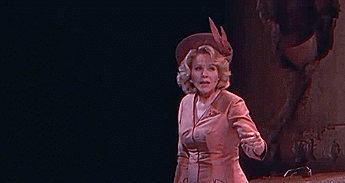
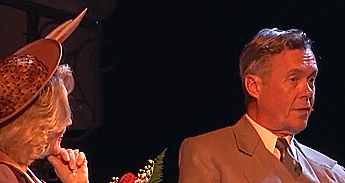
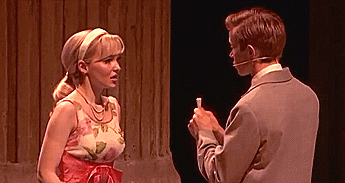
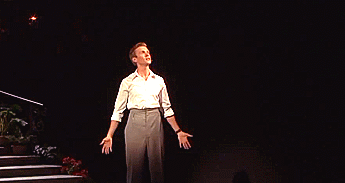
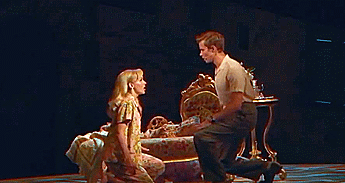




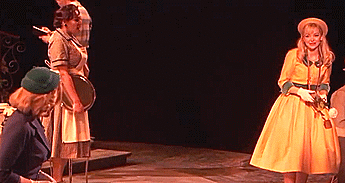
The Light in the Piazza Pt. 2 (Southbank Centre)
#the light in the piazza#my gifs: the light in the piazza#the light in the piazza 2019#my gifs: the light in the piazza 2019#dove cameron#clara johnson#renée fleming#margaret johnson#rob houchen#fabrizio naccarelli#alex jennings#signor naccarelli#mine#musicalgifs
58 notes
·
View notes